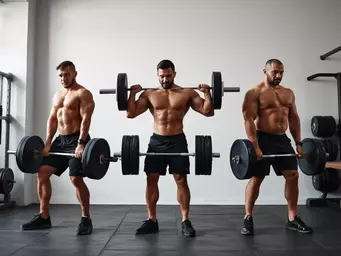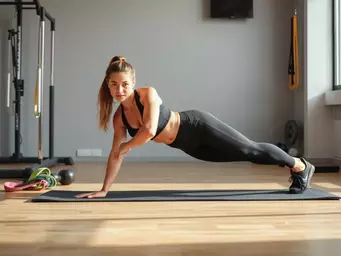Why Building Glutes Matters
- Improved athletic performance
- Injury prevention
- Enhanced balance & posture
- Increased metabolic rate
Foundation for overall fitness.

Glute training can transform your fitness journey, enhancing both performance and confidence. By focusing on effective exercises and recovery strategies, you can achieve your goals right from the comfort of your home. Ready to dive in?
This visual highlights the core components for effective glute development and sustainable recovery, essential for anyone focusing on glute training at home.
Foundation for overall fitness.
Flexible and accessible fitness.
Essential for muscle growth.
Enhance flexibility and recovery.
When it comes to fitness, the glutes play a pivotal role in our overall strength and stability. At Exercises for Butt, I emphasize that building and toning your glutes isn't just about aesthetics—it's about enhancing your performance in everyday activities and workouts! A strong backside supports your posture and can help prevent injuries. For a deeper dive into evidence-based approaches to glute strength training, you can refer to resources like those provided by ACE Fitness.
By focusing on glute training, you're engaging some of the largest muscles in your body. This not only contributes to better athletic performance but also boosts metabolism. Let's uncover why training your glutes matters even at home!
It's clear that having strong glutes can have a significant impact on your fitness journey. If you’re looking to boost your confidence and performance, glute training is the way to go! It’s not just about getting the perfect shape; it's about feeling powerful and capable in your daily life. For more insights on effective glute exercises and their benefits, you can explore articles from The Prehab Guys.
Working out at home offers convenience and flexibility, allowing you to tailor your training to fit your own schedule. This is especially true for glute workouts, as many effective exercises require minimal equipment. You can get started right away with just your body weight, or add resistance bands for an extra challenge!
At Exercises for Butt, I believe that the best workout is one that you enjoy and can stick with. Home workouts also allow you to experiment with various exercises until you find what works best for you. So, get ready to embrace the comfort of your home while building those glutes!
Building strong glutes is a journey. We want to know: What motivates you the most to focus on glute training? Select your answer below:
Recovery is just as vital as your glute workouts! It’s essential to give your muscles the care they need to grow and strengthen after each session. At Exercises for Butt, I focus not just on building those glutes but also on ensuring that recovery strategies are in place. Let’s dive into some effective recovery methods that you can easily incorporate into your routine!
After an intense workout, stretching and mobility exercises play a crucial role in enhancing your performance and preventing injuries. Incorporating these practices not only helps your muscles recover but also improves your overall flexibility. Here are some essential stretches:
Remember, stretching should be a part of your post-workout routine. It can enhance your range of motion and prepare your muscles for future workouts! You can find more information on effective glute exercises and their mechanics from resources like ATHLEAN-X, which delves into how to best target these muscles.
Don’t skip the cool-down! Taking the time to properly cool down after your glute exercises helps your body transition back to a resting state. Here are a few techniques you can try:
Incorporating these cool-down techniques into your routine can significantly enhance your recovery process, allowing you to hit your next workout even stronger!
Nourishment is key to achieving your glute goals! Proper nutrition fuels your body and aids in muscle recovery. Here are some nutrition tips to consider:
Pay attention to your nutrition as it plays a significant role in your fitness journey. You’ll notice the difference in your performance and recovery times!
Sometimes, getting enough protein through food alone can be challenging. That’s where protein supplements come into play! They can be a convenient way to increase your intake. Here’s how they can help:
While whole foods should be your priority, protein supplements can be a helpful addition to your diet when aiming for stronger glutes.
Here is a quick recap of the important points discussed in the article:
Glute training is important for several reasons, including improved athletic performance, injury prevention (by stabilizing hips and lower back), enhanced balance and posture, and an increased metabolic rate due to muscle building.
Home workouts for glute development are cost-effective, offer privacy and comfort, can be customized to fit your schedule, and save time by eliminating travel to a gym.
Essential recovery strategies include stretching and mobility work (like Hip Flexor Stretch, Figure Four Stretch, and Pigeon Pose), cool-down techniques (such as light cardio, foam rolling, and deep breathing), and proper nutrition.
To support muscle building and toning, focus on eating protein-rich foods, staying well-hydrated, and including healthy fats in your diet. Protein supplements can also be a convenient addition if needed.
Many effective glute exercises can be done with just your body weight. You can add resistance bands for an extra challenge, but extensive or expensive equipment is not necessary.
Glute-Focused Deadlift Variations Explained

Consider this: strong glutes not only enhance your physique but also play a pivotal role in your ove
Boost Your Glute Activation Today

What if I told you that engaging your glutes can significantly enhance your athletic performance and
Dumbbell Moves for Stronger Glutes

Are you ready to strengthen your glutes and boost your confidence? Dive into the world of effective
Glute-Focused Deadlift Variations Explained
Boost Your Glute Activation Today
Dumbbell Moves for Stronger Glutes
Hip Thrusts or Squats: Choose Wisely
Glute Activation Moves Before Workouts